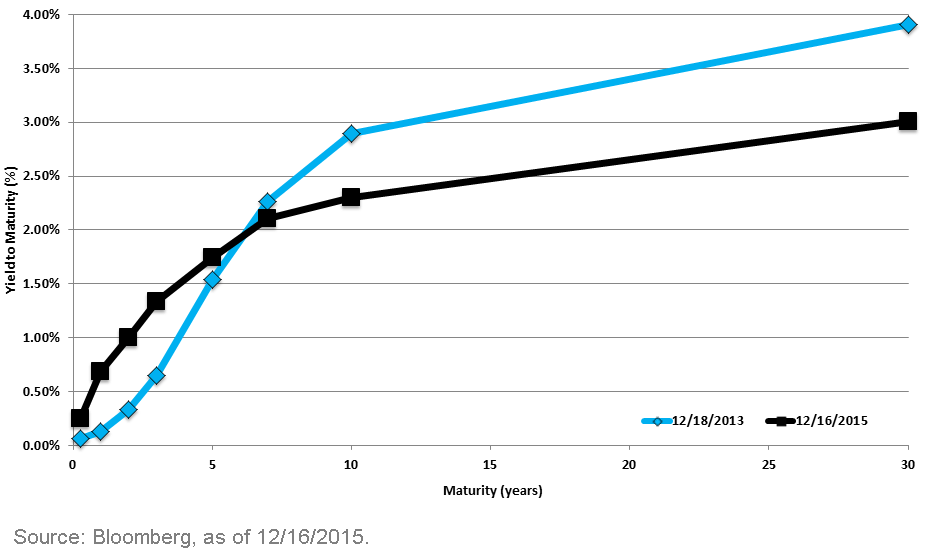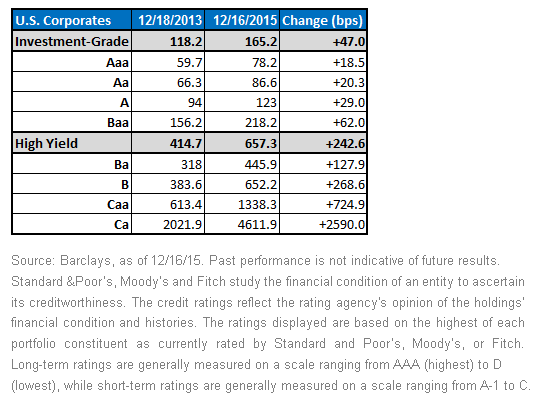From Tapering to First Tightening: What’s Changed in the Bond Market?


 For definitions of terms on the chart, visit our glossary.
As we noted last week, investment-grade (IG) credit performed fairly well during the 2004 tightening cycle. Examining the impact on the market since the tapering, the BBB/Baa segment of the market saw credit spreads widen by 62 bps, nearly offsetting the decline in 10-Year Treasruies. In sum, all-in borrowing costs of benchmark issues have not materially changed in the past two years, despite the evolution of Fed policy. Below, in addition to investment grade, we also examine the moves across the various credit ratings buckets of high yield.
U.S. Credit Spreads across Ratings Buckets
For definitions of terms on the chart, visit our glossary.
As we noted last week, investment-grade (IG) credit performed fairly well during the 2004 tightening cycle. Examining the impact on the market since the tapering, the BBB/Baa segment of the market saw credit spreads widen by 62 bps, nearly offsetting the decline in 10-Year Treasruies. In sum, all-in borrowing costs of benchmark issues have not materially changed in the past two years, despite the evolution of Fed policy. Below, in addition to investment grade, we also examine the moves across the various credit ratings buckets of high yield.
U.S. Credit Spreads across Ratings Buckets
 With commodities down over 38%2 in the last two years, the perceived risk of defaults from borrowers in the Materials and Energy sectors is having a profound impact on the high-yield bond market. With uncertainty surrounding the pace and timing of Fed rate hikes, a general desire to de-risk before the end of the year, and persistent concerns about bond market liquidity, spreads have widened materially in the past several days. Additionally, the restriction of redemptions by one high-yield mutual fund with concentrated positions in the lowest rated, least liquid segment of the market does little to improve investor sentiment/flows. In our view, current depressed valuations do not reflect fundamentals, but absent demand, spreads could continue to languish in the short run.
In response to changes at the Fed and a sustained improvement in the economy, we continue to believe that U.S. interest rates will rise over the coming year. While credit has come under pressure, particularly in the highest-yielding segments of the market, we believe that we are nowhere near the end of the current credit cycle. As a result, investors should consider hedging interest rate risk while maintaining exposure to credit as our favored approach to positioning for additional Fed tightening. For investment grade, the Barclays Rate Hedged U.S. Aggregate Bond Index, Zero Duration shows the performance of the Barclays U.S. Aggregate Index with duration hedged to zero years. For greater credit risk, the BofA Merrill Lynch 0-5 Year US high Yield Constrained, Zero Duration Index tracks the returns of non-IG credit hedged to zero years.
1Source: Bloomberg, as of 12/16/15.
2As proxied by the Bloomberg Commodity Index.
With commodities down over 38%2 in the last two years, the perceived risk of defaults from borrowers in the Materials and Energy sectors is having a profound impact on the high-yield bond market. With uncertainty surrounding the pace and timing of Fed rate hikes, a general desire to de-risk before the end of the year, and persistent concerns about bond market liquidity, spreads have widened materially in the past several days. Additionally, the restriction of redemptions by one high-yield mutual fund with concentrated positions in the lowest rated, least liquid segment of the market does little to improve investor sentiment/flows. In our view, current depressed valuations do not reflect fundamentals, but absent demand, spreads could continue to languish in the short run.
In response to changes at the Fed and a sustained improvement in the economy, we continue to believe that U.S. interest rates will rise over the coming year. While credit has come under pressure, particularly in the highest-yielding segments of the market, we believe that we are nowhere near the end of the current credit cycle. As a result, investors should consider hedging interest rate risk while maintaining exposure to credit as our favored approach to positioning for additional Fed tightening. For investment grade, the Barclays Rate Hedged U.S. Aggregate Bond Index, Zero Duration shows the performance of the Barclays U.S. Aggregate Index with duration hedged to zero years. For greater credit risk, the BofA Merrill Lynch 0-5 Year US high Yield Constrained, Zero Duration Index tracks the returns of non-IG credit hedged to zero years.
1Source: Bloomberg, as of 12/16/15.
2As proxied by the Bloomberg Commodity Index.
Important Risks Related to this Article
Fixed income investments are subject to interest rate risk; their value will normally decline as interest rates rise. In addition, when interest rates fall, income may decline. Fixed income investments are also subject to credit risk, the risk that the issuer of a bond will fail to pay interest and principal in a timely manner or that negative perceptions of the issuer’s ability to make such payments will cause the price of that bond to decline.


